Rohingya Crisis and its Political Impact: A Policy Paper
VerifiedAdded on 2022/10/04
|15
|4351
|48
Report
AI Summary
This policy paper delves into the Rohingya crisis, examining its origins in Myanmar, the forced displacement of the Rohingya people, and the resulting humanitarian and political impacts. The paper provides a detailed analysis of the situation, including the role of the Myanmar government, the Arakan Rohingya Salvation Army (ARSA), and the challenges faced by neighboring countries like Bangladesh. It explores the religious and ethnic dimensions of the conflict, the utilization of natural resources as a factor, and the limitations of international actors in resolving the issue. The paper highlights the human rights violations, the impact on civilians, and the specific vulnerabilities of women and children within the refugee population. Ultimately, the paper offers policy recommendations aimed at addressing the crisis, advocating for solutions to alleviate the suffering of the Rohingya people and promote regional stability.
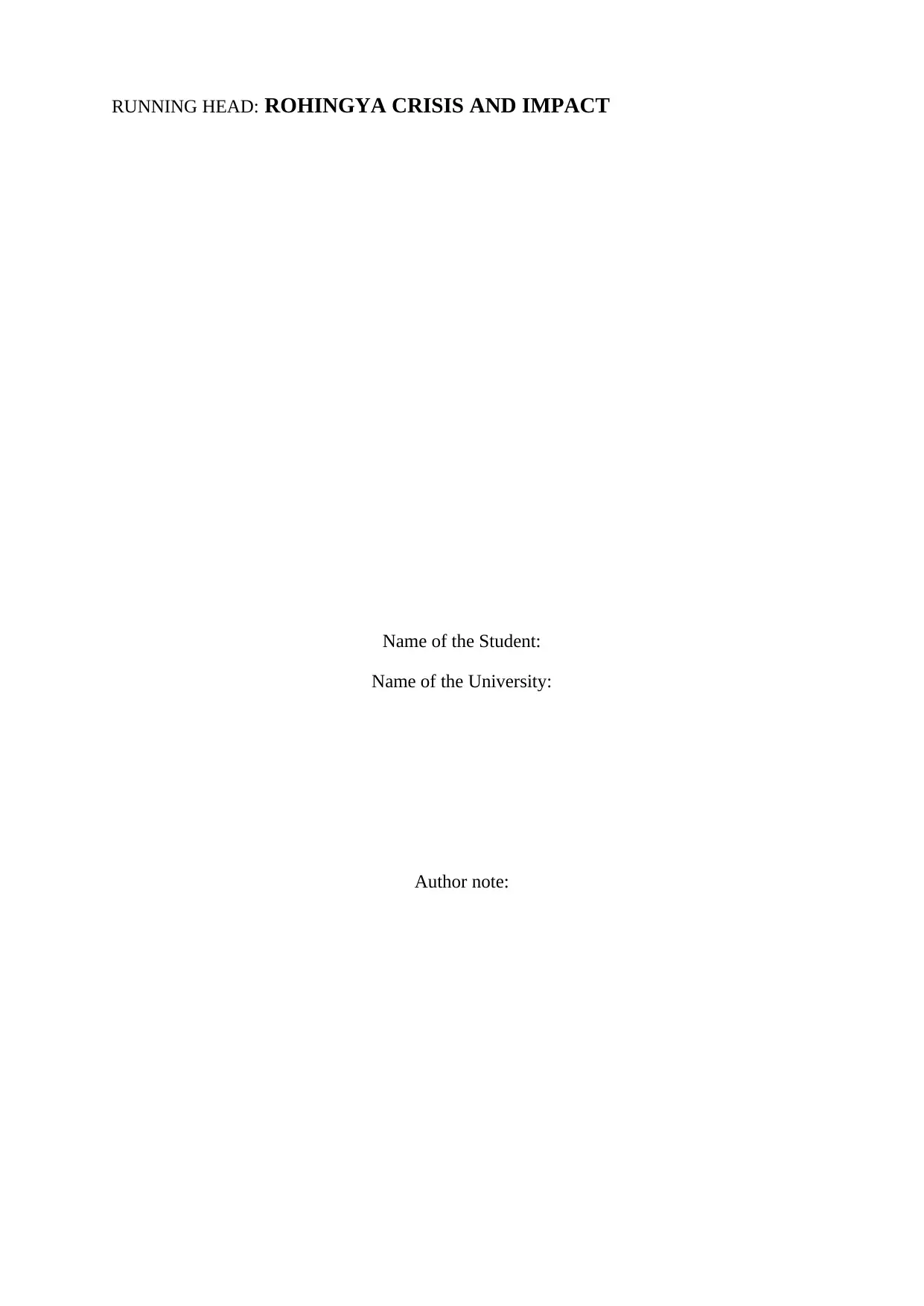
RUNNING HEAD: ROHINGYA CRISIS AND IMPACT
Name of the Student:
Name of the University:
Author note:
Name of the Student:
Name of the University:
Author note:
Paraphrase This Document
Need a fresh take? Get an instant paraphrase of this document with our AI Paraphraser
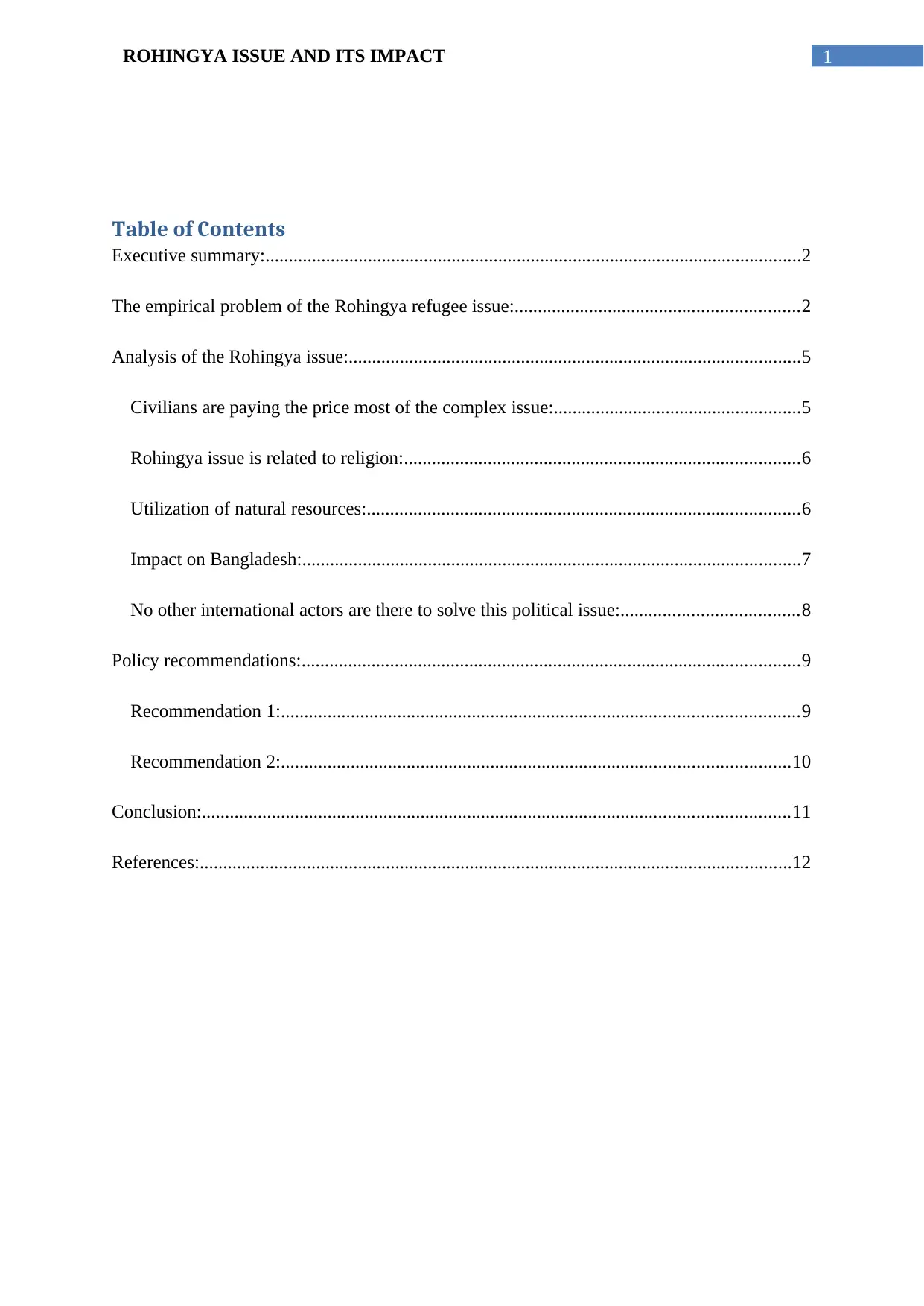
1ROHINGYA ISSUE AND ITS IMPACT
Table of Contents
Executive summary:...................................................................................................................2
The empirical problem of the Rohingya refugee issue:.............................................................2
Analysis of the Rohingya issue:.................................................................................................5
Civilians are paying the price most of the complex issue:.....................................................5
Rohingya issue is related to religion:.....................................................................................6
Utilization of natural resources:.............................................................................................6
Impact on Bangladesh:...........................................................................................................7
No other international actors are there to solve this political issue:......................................8
Policy recommendations:...........................................................................................................9
Recommendation 1:...............................................................................................................9
Recommendation 2:.............................................................................................................10
Conclusion:..............................................................................................................................11
References:...............................................................................................................................12
Table of Contents
Executive summary:...................................................................................................................2
The empirical problem of the Rohingya refugee issue:.............................................................2
Analysis of the Rohingya issue:.................................................................................................5
Civilians are paying the price most of the complex issue:.....................................................5
Rohingya issue is related to religion:.....................................................................................6
Utilization of natural resources:.............................................................................................6
Impact on Bangladesh:...........................................................................................................7
No other international actors are there to solve this political issue:......................................8
Policy recommendations:...........................................................................................................9
Recommendation 1:...............................................................................................................9
Recommendation 2:.............................................................................................................10
Conclusion:..............................................................................................................................11
References:...............................................................................................................................12
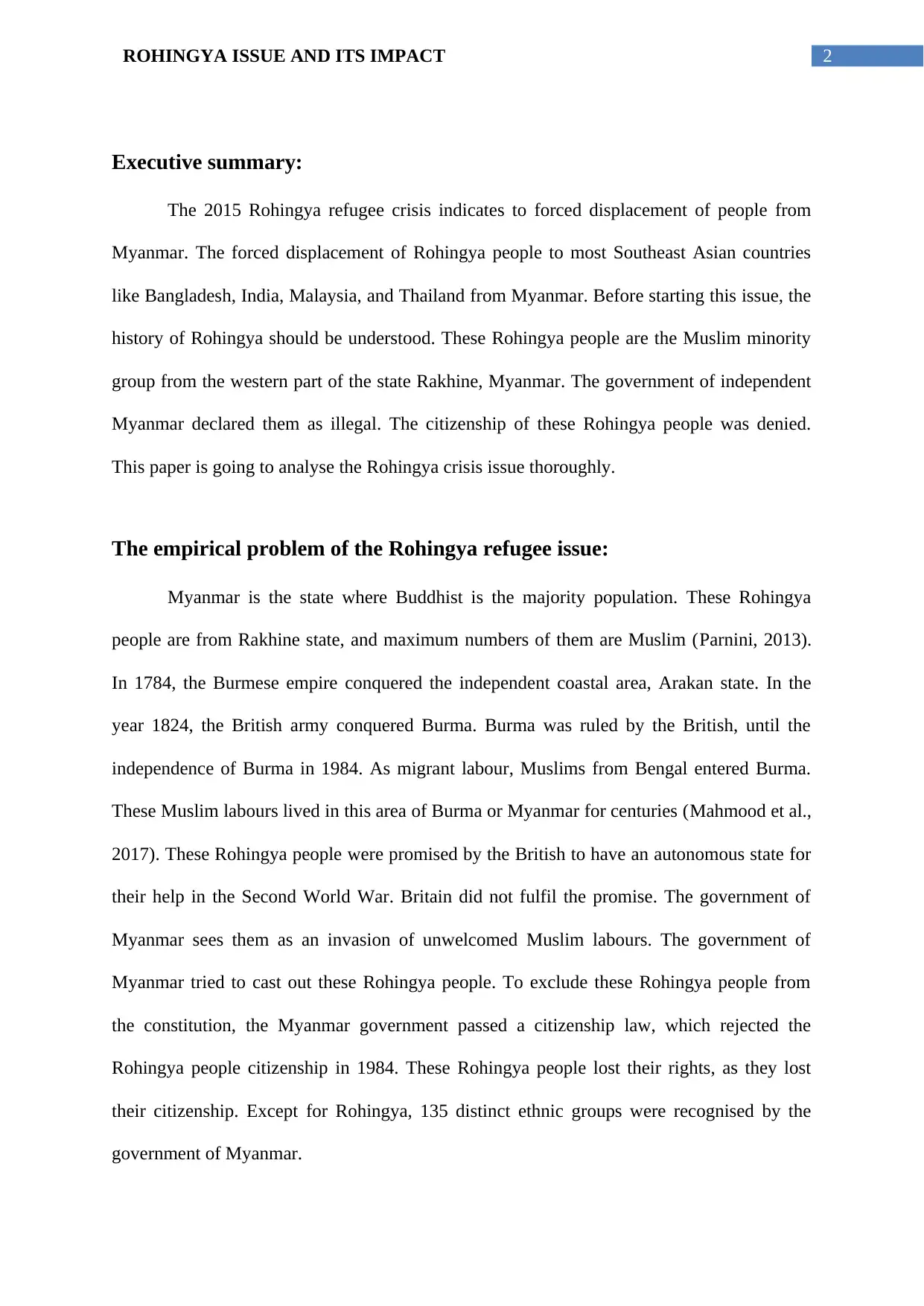
2ROHINGYA ISSUE AND ITS IMPACT
Executive summary:
The 2015 Rohingya refugee crisis indicates to forced displacement of people from
Myanmar. The forced displacement of Rohingya people to most Southeast Asian countries
like Bangladesh, India, Malaysia, and Thailand from Myanmar. Before starting this issue, the
history of Rohingya should be understood. These Rohingya people are the Muslim minority
group from the western part of the state Rakhine, Myanmar. The government of independent
Myanmar declared them as illegal. The citizenship of these Rohingya people was denied.
This paper is going to analyse the Rohingya crisis issue thoroughly.
The empirical problem of the Rohingya refugee issue:
Myanmar is the state where Buddhist is the majority population. These Rohingya
people are from Rakhine state, and maximum numbers of them are Muslim (Parnini, 2013).
In 1784, the Burmese empire conquered the independent coastal area, Arakan state. In the
year 1824, the British army conquered Burma. Burma was ruled by the British, until the
independence of Burma in 1984. As migrant labour, Muslims from Bengal entered Burma.
These Muslim labours lived in this area of Burma or Myanmar for centuries (Mahmood et al.,
2017). These Rohingya people were promised by the British to have an autonomous state for
their help in the Second World War. Britain did not fulfil the promise. The government of
Myanmar sees them as an invasion of unwelcomed Muslim labours. The government of
Myanmar tried to cast out these Rohingya people. To exclude these Rohingya people from
the constitution, the Myanmar government passed a citizenship law, which rejected the
Rohingya people citizenship in 1984. These Rohingya people lost their rights, as they lost
their citizenship. Except for Rohingya, 135 distinct ethnic groups were recognised by the
government of Myanmar.
Executive summary:
The 2015 Rohingya refugee crisis indicates to forced displacement of people from
Myanmar. The forced displacement of Rohingya people to most Southeast Asian countries
like Bangladesh, India, Malaysia, and Thailand from Myanmar. Before starting this issue, the
history of Rohingya should be understood. These Rohingya people are the Muslim minority
group from the western part of the state Rakhine, Myanmar. The government of independent
Myanmar declared them as illegal. The citizenship of these Rohingya people was denied.
This paper is going to analyse the Rohingya crisis issue thoroughly.
The empirical problem of the Rohingya refugee issue:
Myanmar is the state where Buddhist is the majority population. These Rohingya
people are from Rakhine state, and maximum numbers of them are Muslim (Parnini, 2013).
In 1784, the Burmese empire conquered the independent coastal area, Arakan state. In the
year 1824, the British army conquered Burma. Burma was ruled by the British, until the
independence of Burma in 1984. As migrant labour, Muslims from Bengal entered Burma.
These Muslim labours lived in this area of Burma or Myanmar for centuries (Mahmood et al.,
2017). These Rohingya people were promised by the British to have an autonomous state for
their help in the Second World War. Britain did not fulfil the promise. The government of
Myanmar sees them as an invasion of unwelcomed Muslim labours. The government of
Myanmar tried to cast out these Rohingya people. To exclude these Rohingya people from
the constitution, the Myanmar government passed a citizenship law, which rejected the
Rohingya people citizenship in 1984. These Rohingya people lost their rights, as they lost
their citizenship. Except for Rohingya, 135 distinct ethnic groups were recognised by the
government of Myanmar.
⊘ This is a preview!⊘
Do you want full access?
Subscribe today to unlock all pages.

Trusted by 1+ million students worldwide
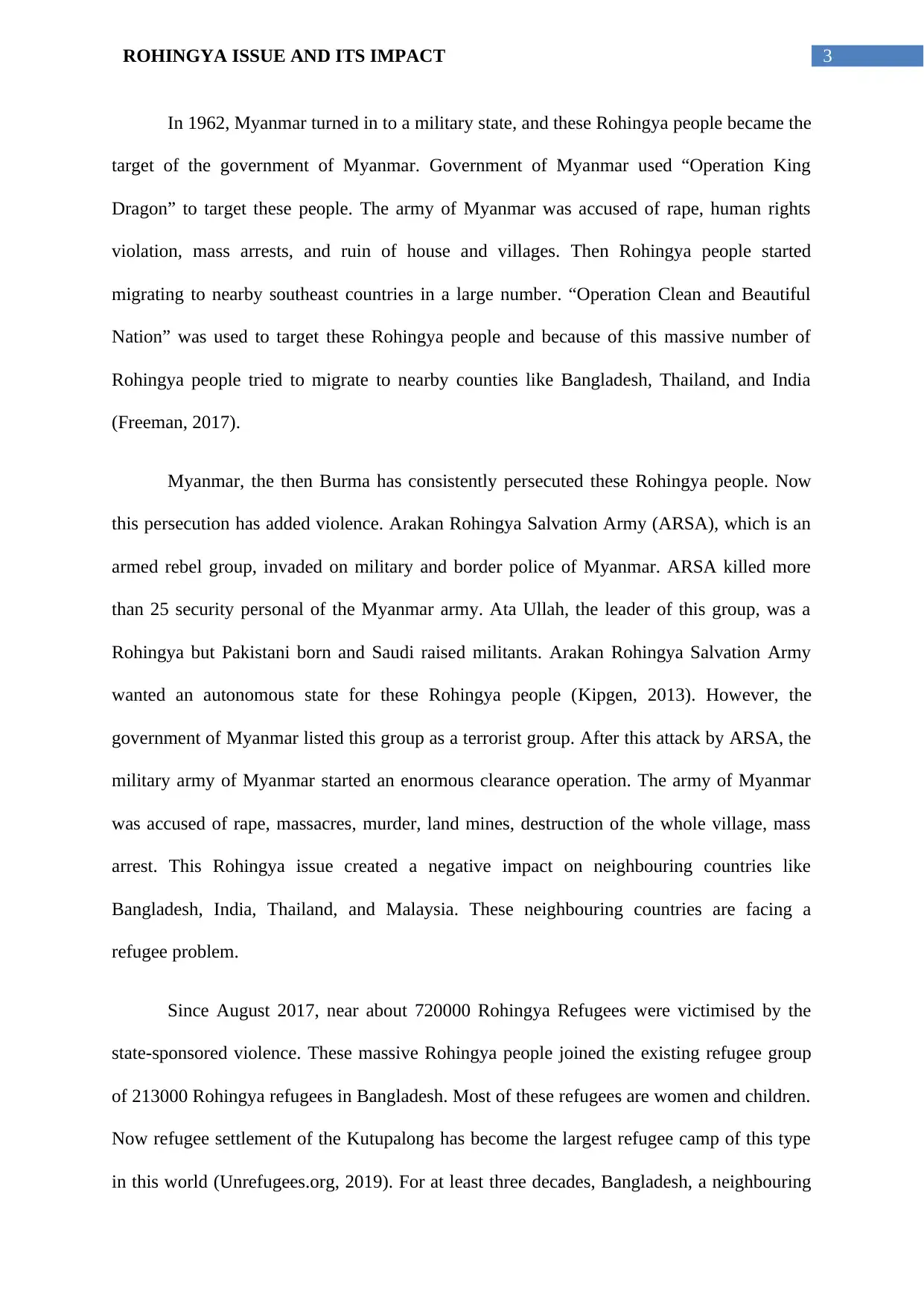
3ROHINGYA ISSUE AND ITS IMPACT
In 1962, Myanmar turned in to a military state, and these Rohingya people became the
target of the government of Myanmar. Government of Myanmar used “Operation King
Dragon” to target these people. The army of Myanmar was accused of rape, human rights
violation, mass arrests, and ruin of house and villages. Then Rohingya people started
migrating to nearby southeast countries in a large number. “Operation Clean and Beautiful
Nation” was used to target these Rohingya people and because of this massive number of
Rohingya people tried to migrate to nearby counties like Bangladesh, Thailand, and India
(Freeman, 2017).
Myanmar, the then Burma has consistently persecuted these Rohingya people. Now
this persecution has added violence. Arakan Rohingya Salvation Army (ARSA), which is an
armed rebel group, invaded on military and border police of Myanmar. ARSA killed more
than 25 security personal of the Myanmar army. Ata Ullah, the leader of this group, was a
Rohingya but Pakistani born and Saudi raised militants. Arakan Rohingya Salvation Army
wanted an autonomous state for these Rohingya people (Kipgen, 2013). However, the
government of Myanmar listed this group as a terrorist group. After this attack by ARSA, the
military army of Myanmar started an enormous clearance operation. The army of Myanmar
was accused of rape, massacres, murder, land mines, destruction of the whole village, mass
arrest. This Rohingya issue created a negative impact on neighbouring countries like
Bangladesh, India, Thailand, and Malaysia. These neighbouring countries are facing a
refugee problem.
Since August 2017, near about 720000 Rohingya Refugees were victimised by the
state-sponsored violence. These massive Rohingya people joined the existing refugee group
of 213000 Rohingya refugees in Bangladesh. Most of these refugees are women and children.
Now refugee settlement of the Kutupalong has become the largest refugee camp of this type
in this world (Unrefugees.org, 2019). For at least three decades, Bangladesh, a neighbouring
In 1962, Myanmar turned in to a military state, and these Rohingya people became the
target of the government of Myanmar. Government of Myanmar used “Operation King
Dragon” to target these people. The army of Myanmar was accused of rape, human rights
violation, mass arrests, and ruin of house and villages. Then Rohingya people started
migrating to nearby southeast countries in a large number. “Operation Clean and Beautiful
Nation” was used to target these Rohingya people and because of this massive number of
Rohingya people tried to migrate to nearby counties like Bangladesh, Thailand, and India
(Freeman, 2017).
Myanmar, the then Burma has consistently persecuted these Rohingya people. Now
this persecution has added violence. Arakan Rohingya Salvation Army (ARSA), which is an
armed rebel group, invaded on military and border police of Myanmar. ARSA killed more
than 25 security personal of the Myanmar army. Ata Ullah, the leader of this group, was a
Rohingya but Pakistani born and Saudi raised militants. Arakan Rohingya Salvation Army
wanted an autonomous state for these Rohingya people (Kipgen, 2013). However, the
government of Myanmar listed this group as a terrorist group. After this attack by ARSA, the
military army of Myanmar started an enormous clearance operation. The army of Myanmar
was accused of rape, massacres, murder, land mines, destruction of the whole village, mass
arrest. This Rohingya issue created a negative impact on neighbouring countries like
Bangladesh, India, Thailand, and Malaysia. These neighbouring countries are facing a
refugee problem.
Since August 2017, near about 720000 Rohingya Refugees were victimised by the
state-sponsored violence. These massive Rohingya people joined the existing refugee group
of 213000 Rohingya refugees in Bangladesh. Most of these refugees are women and children.
Now refugee settlement of the Kutupalong has become the largest refugee camp of this type
in this world (Unrefugees.org, 2019). For at least three decades, Bangladesh, a neighbouring
Paraphrase This Document
Need a fresh take? Get an instant paraphrase of this document with our AI Paraphraser
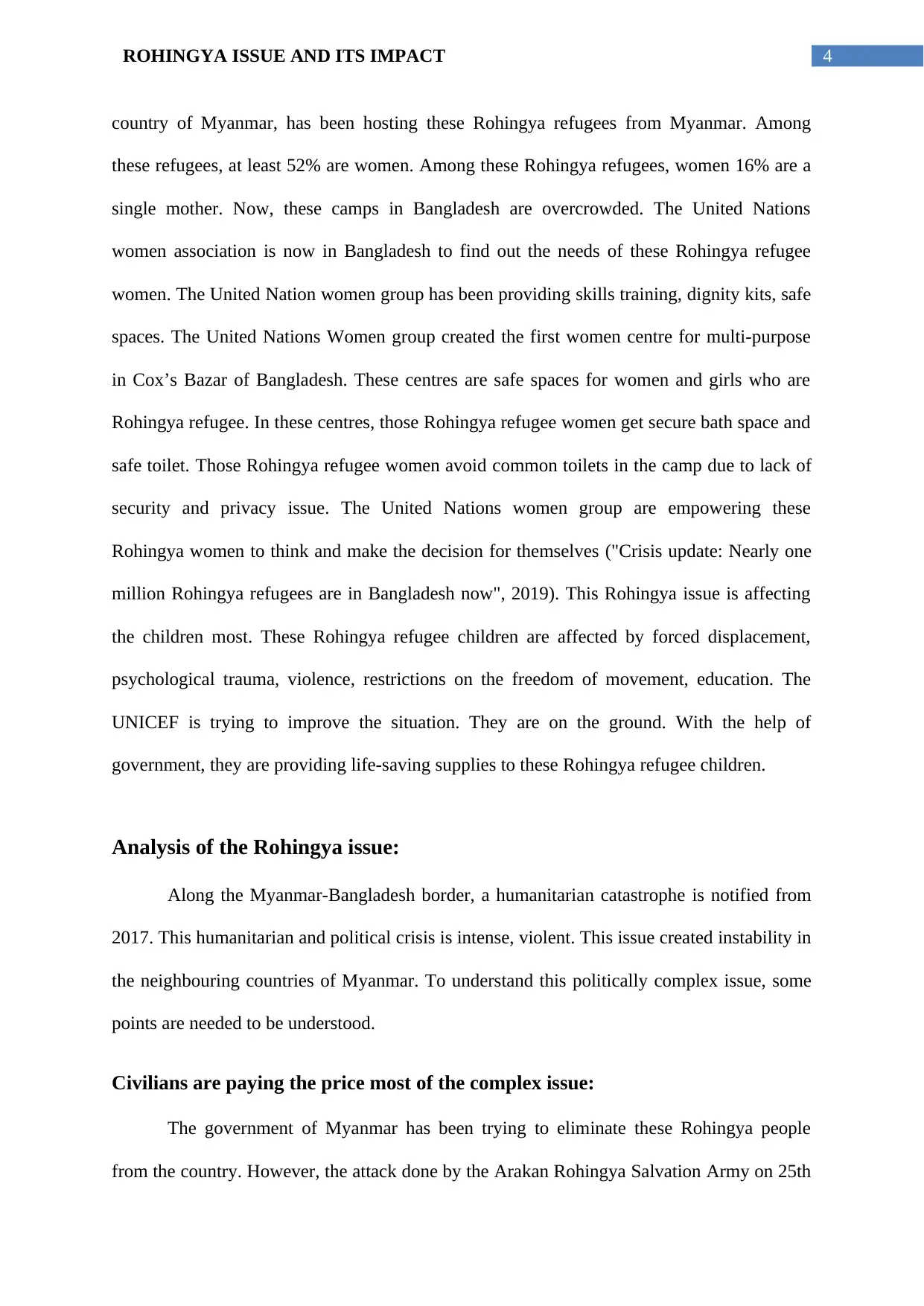
4ROHINGYA ISSUE AND ITS IMPACT
country of Myanmar, has been hosting these Rohingya refugees from Myanmar. Among
these refugees, at least 52% are women. Among these Rohingya refugees, women 16% are a
single mother. Now, these camps in Bangladesh are overcrowded. The United Nations
women association is now in Bangladesh to find out the needs of these Rohingya refugee
women. The United Nation women group has been providing skills training, dignity kits, safe
spaces. The United Nations Women group created the first women centre for multi-purpose
in Cox’s Bazar of Bangladesh. These centres are safe spaces for women and girls who are
Rohingya refugee. In these centres, those Rohingya refugee women get secure bath space and
safe toilet. Those Rohingya refugee women avoid common toilets in the camp due to lack of
security and privacy issue. The United Nations women group are empowering these
Rohingya women to think and make the decision for themselves ("Crisis update: Nearly one
million Rohingya refugees are in Bangladesh now", 2019). This Rohingya issue is affecting
the children most. These Rohingya refugee children are affected by forced displacement,
psychological trauma, violence, restrictions on the freedom of movement, education. The
UNICEF is trying to improve the situation. They are on the ground. With the help of
government, they are providing life-saving supplies to these Rohingya refugee children.
Analysis of the Rohingya issue:
Along the Myanmar-Bangladesh border, a humanitarian catastrophe is notified from
2017. This humanitarian and political crisis is intense, violent. This issue created instability in
the neighbouring countries of Myanmar. To understand this politically complex issue, some
points are needed to be understood.
Civilians are paying the price most of the complex issue:
The government of Myanmar has been trying to eliminate these Rohingya people
from the country. However, the attack done by the Arakan Rohingya Salvation Army on 25th
country of Myanmar, has been hosting these Rohingya refugees from Myanmar. Among
these refugees, at least 52% are women. Among these Rohingya refugees, women 16% are a
single mother. Now, these camps in Bangladesh are overcrowded. The United Nations
women association is now in Bangladesh to find out the needs of these Rohingya refugee
women. The United Nation women group has been providing skills training, dignity kits, safe
spaces. The United Nations Women group created the first women centre for multi-purpose
in Cox’s Bazar of Bangladesh. These centres are safe spaces for women and girls who are
Rohingya refugee. In these centres, those Rohingya refugee women get secure bath space and
safe toilet. Those Rohingya refugee women avoid common toilets in the camp due to lack of
security and privacy issue. The United Nations women group are empowering these
Rohingya women to think and make the decision for themselves ("Crisis update: Nearly one
million Rohingya refugees are in Bangladesh now", 2019). This Rohingya issue is affecting
the children most. These Rohingya refugee children are affected by forced displacement,
psychological trauma, violence, restrictions on the freedom of movement, education. The
UNICEF is trying to improve the situation. They are on the ground. With the help of
government, they are providing life-saving supplies to these Rohingya refugee children.
Analysis of the Rohingya issue:
Along the Myanmar-Bangladesh border, a humanitarian catastrophe is notified from
2017. This humanitarian and political crisis is intense, violent. This issue created instability in
the neighbouring countries of Myanmar. To understand this politically complex issue, some
points are needed to be understood.
Civilians are paying the price most of the complex issue:
The government of Myanmar has been trying to eliminate these Rohingya people
from the country. However, the attack done by the Arakan Rohingya Salvation Army on 25th
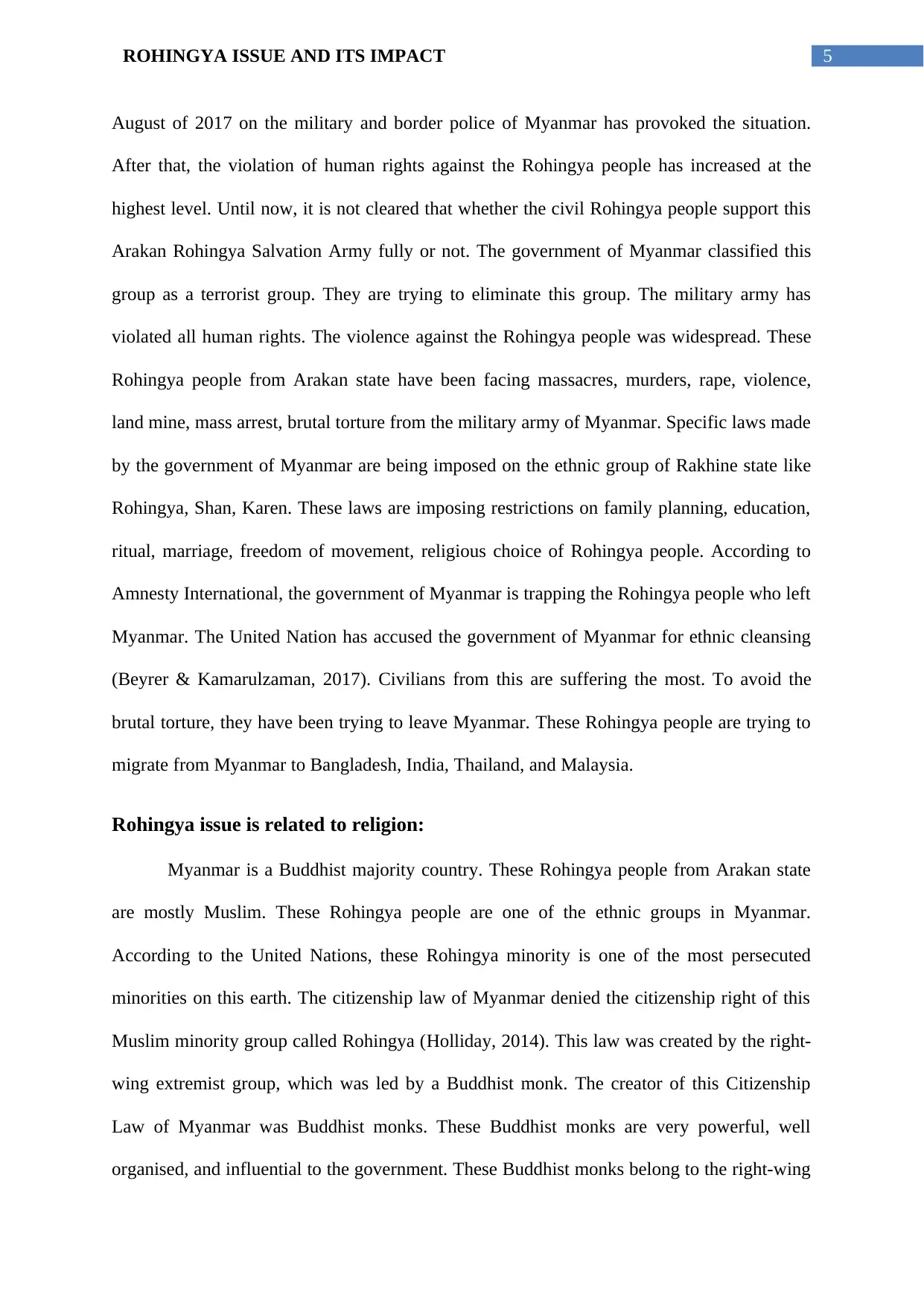
5ROHINGYA ISSUE AND ITS IMPACT
August of 2017 on the military and border police of Myanmar has provoked the situation.
After that, the violation of human rights against the Rohingya people has increased at the
highest level. Until now, it is not cleared that whether the civil Rohingya people support this
Arakan Rohingya Salvation Army fully or not. The government of Myanmar classified this
group as a terrorist group. They are trying to eliminate this group. The military army has
violated all human rights. The violence against the Rohingya people was widespread. These
Rohingya people from Arakan state have been facing massacres, murders, rape, violence,
land mine, mass arrest, brutal torture from the military army of Myanmar. Specific laws made
by the government of Myanmar are being imposed on the ethnic group of Rakhine state like
Rohingya, Shan, Karen. These laws are imposing restrictions on family planning, education,
ritual, marriage, freedom of movement, religious choice of Rohingya people. According to
Amnesty International, the government of Myanmar is trapping the Rohingya people who left
Myanmar. The United Nation has accused the government of Myanmar for ethnic cleansing
(Beyrer & Kamarulzaman, 2017). Civilians from this are suffering the most. To avoid the
brutal torture, they have been trying to leave Myanmar. These Rohingya people are trying to
migrate from Myanmar to Bangladesh, India, Thailand, and Malaysia.
Rohingya issue is related to religion:
Myanmar is a Buddhist majority country. These Rohingya people from Arakan state
are mostly Muslim. These Rohingya people are one of the ethnic groups in Myanmar.
According to the United Nations, these Rohingya minority is one of the most persecuted
minorities on this earth. The citizenship law of Myanmar denied the citizenship right of this
Muslim minority group called Rohingya (Holliday, 2014). This law was created by the right-
wing extremist group, which was led by a Buddhist monk. The creator of this Citizenship
Law of Myanmar was Buddhist monks. These Buddhist monks are very powerful, well
organised, and influential to the government. These Buddhist monks belong to the right-wing
August of 2017 on the military and border police of Myanmar has provoked the situation.
After that, the violation of human rights against the Rohingya people has increased at the
highest level. Until now, it is not cleared that whether the civil Rohingya people support this
Arakan Rohingya Salvation Army fully or not. The government of Myanmar classified this
group as a terrorist group. They are trying to eliminate this group. The military army has
violated all human rights. The violence against the Rohingya people was widespread. These
Rohingya people from Arakan state have been facing massacres, murders, rape, violence,
land mine, mass arrest, brutal torture from the military army of Myanmar. Specific laws made
by the government of Myanmar are being imposed on the ethnic group of Rakhine state like
Rohingya, Shan, Karen. These laws are imposing restrictions on family planning, education,
ritual, marriage, freedom of movement, religious choice of Rohingya people. According to
Amnesty International, the government of Myanmar is trapping the Rohingya people who left
Myanmar. The United Nation has accused the government of Myanmar for ethnic cleansing
(Beyrer & Kamarulzaman, 2017). Civilians from this are suffering the most. To avoid the
brutal torture, they have been trying to leave Myanmar. These Rohingya people are trying to
migrate from Myanmar to Bangladesh, India, Thailand, and Malaysia.
Rohingya issue is related to religion:
Myanmar is a Buddhist majority country. These Rohingya people from Arakan state
are mostly Muslim. These Rohingya people are one of the ethnic groups in Myanmar.
According to the United Nations, these Rohingya minority is one of the most persecuted
minorities on this earth. The citizenship law of Myanmar denied the citizenship right of this
Muslim minority group called Rohingya (Holliday, 2014). This law was created by the right-
wing extremist group, which was led by a Buddhist monk. The creator of this Citizenship
Law of Myanmar was Buddhist monks. These Buddhist monks are very powerful, well
organised, and influential to the government. These Buddhist monks belong to the right-wing
⊘ This is a preview!⊘
Do you want full access?
Subscribe today to unlock all pages.

Trusted by 1+ million students worldwide
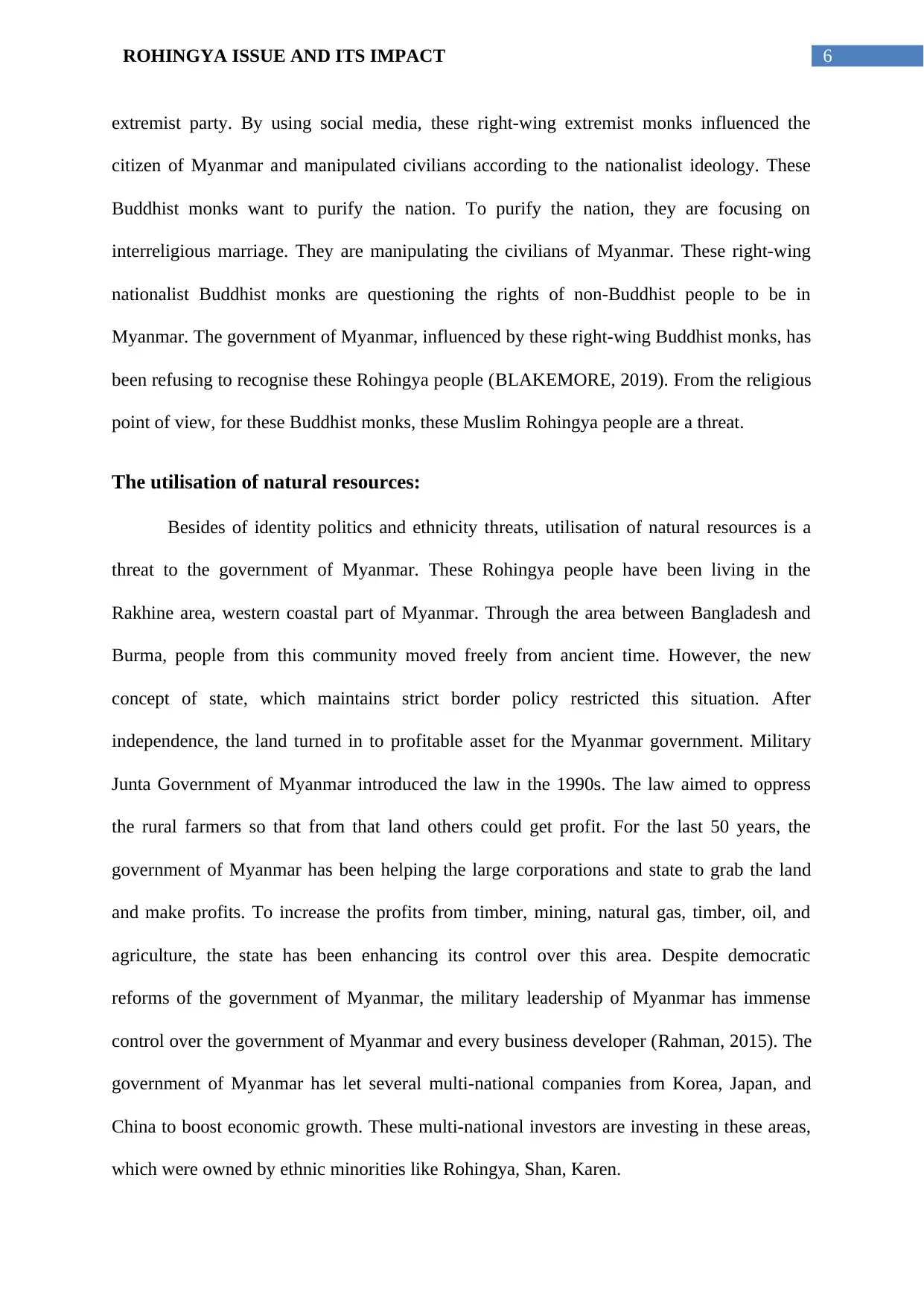
6ROHINGYA ISSUE AND ITS IMPACT
extremist party. By using social media, these right-wing extremist monks influenced the
citizen of Myanmar and manipulated civilians according to the nationalist ideology. These
Buddhist monks want to purify the nation. To purify the nation, they are focusing on
interreligious marriage. They are manipulating the civilians of Myanmar. These right-wing
nationalist Buddhist monks are questioning the rights of non-Buddhist people to be in
Myanmar. The government of Myanmar, influenced by these right-wing Buddhist monks, has
been refusing to recognise these Rohingya people (BLAKEMORE, 2019). From the religious
point of view, for these Buddhist monks, these Muslim Rohingya people are a threat.
The utilisation of natural resources:
Besides of identity politics and ethnicity threats, utilisation of natural resources is a
threat to the government of Myanmar. These Rohingya people have been living in the
Rakhine area, western coastal part of Myanmar. Through the area between Bangladesh and
Burma, people from this community moved freely from ancient time. However, the new
concept of state, which maintains strict border policy restricted this situation. After
independence, the land turned in to profitable asset for the Myanmar government. Military
Junta Government of Myanmar introduced the law in the 1990s. The law aimed to oppress
the rural farmers so that from that land others could get profit. For the last 50 years, the
government of Myanmar has been helping the large corporations and state to grab the land
and make profits. To increase the profits from timber, mining, natural gas, timber, oil, and
agriculture, the state has been enhancing its control over this area. Despite democratic
reforms of the government of Myanmar, the military leadership of Myanmar has immense
control over the government of Myanmar and every business developer (Rahman, 2015). The
government of Myanmar has let several multi-national companies from Korea, Japan, and
China to boost economic growth. These multi-national investors are investing in these areas,
which were owned by ethnic minorities like Rohingya, Shan, Karen.
extremist party. By using social media, these right-wing extremist monks influenced the
citizen of Myanmar and manipulated civilians according to the nationalist ideology. These
Buddhist monks want to purify the nation. To purify the nation, they are focusing on
interreligious marriage. They are manipulating the civilians of Myanmar. These right-wing
nationalist Buddhist monks are questioning the rights of non-Buddhist people to be in
Myanmar. The government of Myanmar, influenced by these right-wing Buddhist monks, has
been refusing to recognise these Rohingya people (BLAKEMORE, 2019). From the religious
point of view, for these Buddhist monks, these Muslim Rohingya people are a threat.
The utilisation of natural resources:
Besides of identity politics and ethnicity threats, utilisation of natural resources is a
threat to the government of Myanmar. These Rohingya people have been living in the
Rakhine area, western coastal part of Myanmar. Through the area between Bangladesh and
Burma, people from this community moved freely from ancient time. However, the new
concept of state, which maintains strict border policy restricted this situation. After
independence, the land turned in to profitable asset for the Myanmar government. Military
Junta Government of Myanmar introduced the law in the 1990s. The law aimed to oppress
the rural farmers so that from that land others could get profit. For the last 50 years, the
government of Myanmar has been helping the large corporations and state to grab the land
and make profits. To increase the profits from timber, mining, natural gas, timber, oil, and
agriculture, the state has been enhancing its control over this area. Despite democratic
reforms of the government of Myanmar, the military leadership of Myanmar has immense
control over the government of Myanmar and every business developer (Rahman, 2015). The
government of Myanmar has let several multi-national companies from Korea, Japan, and
China to boost economic growth. These multi-national investors are investing in these areas,
which were owned by ethnic minorities like Rohingya, Shan, Karen.
Paraphrase This Document
Need a fresh take? Get an instant paraphrase of this document with our AI Paraphraser
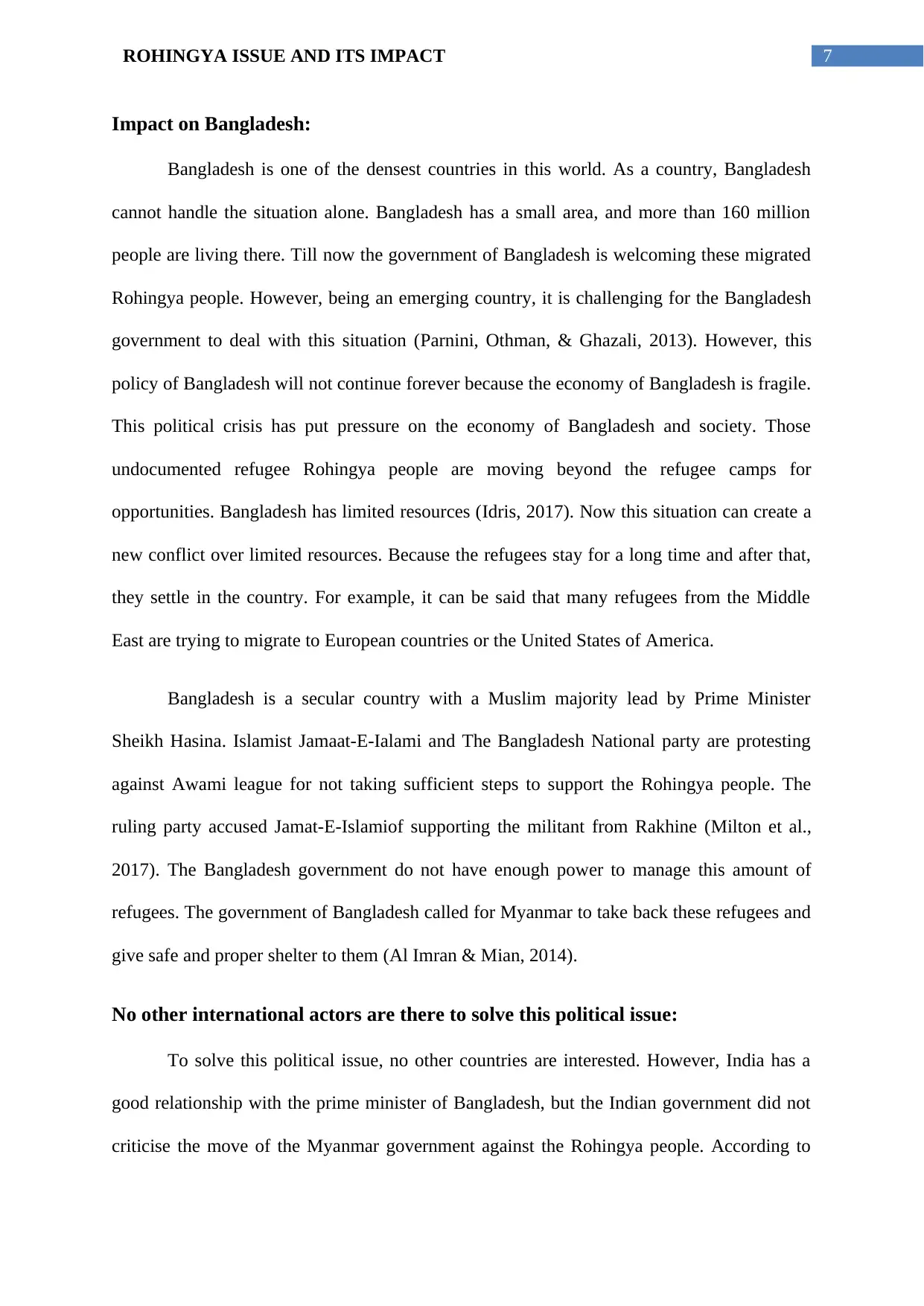
7ROHINGYA ISSUE AND ITS IMPACT
Impact on Bangladesh:
Bangladesh is one of the densest countries in this world. As a country, Bangladesh
cannot handle the situation alone. Bangladesh has a small area, and more than 160 million
people are living there. Till now the government of Bangladesh is welcoming these migrated
Rohingya people. However, being an emerging country, it is challenging for the Bangladesh
government to deal with this situation (Parnini, Othman, & Ghazali, 2013). However, this
policy of Bangladesh will not continue forever because the economy of Bangladesh is fragile.
This political crisis has put pressure on the economy of Bangladesh and society. Those
undocumented refugee Rohingya people are moving beyond the refugee camps for
opportunities. Bangladesh has limited resources (Idris, 2017). Now this situation can create a
new conflict over limited resources. Because the refugees stay for a long time and after that,
they settle in the country. For example, it can be said that many refugees from the Middle
East are trying to migrate to European countries or the United States of America.
Bangladesh is a secular country with a Muslim majority lead by Prime Minister
Sheikh Hasina. Islamist Jamaat-E-Ialami and The Bangladesh National party are protesting
against Awami league for not taking sufficient steps to support the Rohingya people. The
ruling party accused Jamat-E-Islamiof supporting the militant from Rakhine (Milton et al.,
2017). The Bangladesh government do not have enough power to manage this amount of
refugees. The government of Bangladesh called for Myanmar to take back these refugees and
give safe and proper shelter to them (Al Imran & Mian, 2014).
No other international actors are there to solve this political issue:
To solve this political issue, no other countries are interested. However, India has a
good relationship with the prime minister of Bangladesh, but the Indian government did not
criticise the move of the Myanmar government against the Rohingya people. According to
Impact on Bangladesh:
Bangladesh is one of the densest countries in this world. As a country, Bangladesh
cannot handle the situation alone. Bangladesh has a small area, and more than 160 million
people are living there. Till now the government of Bangladesh is welcoming these migrated
Rohingya people. However, being an emerging country, it is challenging for the Bangladesh
government to deal with this situation (Parnini, Othman, & Ghazali, 2013). However, this
policy of Bangladesh will not continue forever because the economy of Bangladesh is fragile.
This political crisis has put pressure on the economy of Bangladesh and society. Those
undocumented refugee Rohingya people are moving beyond the refugee camps for
opportunities. Bangladesh has limited resources (Idris, 2017). Now this situation can create a
new conflict over limited resources. Because the refugees stay for a long time and after that,
they settle in the country. For example, it can be said that many refugees from the Middle
East are trying to migrate to European countries or the United States of America.
Bangladesh is a secular country with a Muslim majority lead by Prime Minister
Sheikh Hasina. Islamist Jamaat-E-Ialami and The Bangladesh National party are protesting
against Awami league for not taking sufficient steps to support the Rohingya people. The
ruling party accused Jamat-E-Islamiof supporting the militant from Rakhine (Milton et al.,
2017). The Bangladesh government do not have enough power to manage this amount of
refugees. The government of Bangladesh called for Myanmar to take back these refugees and
give safe and proper shelter to them (Al Imran & Mian, 2014).
No other international actors are there to solve this political issue:
To solve this political issue, no other countries are interested. However, India has a
good relationship with the prime minister of Bangladesh, but the Indian government did not
criticise the move of the Myanmar government against the Rohingya people. According to
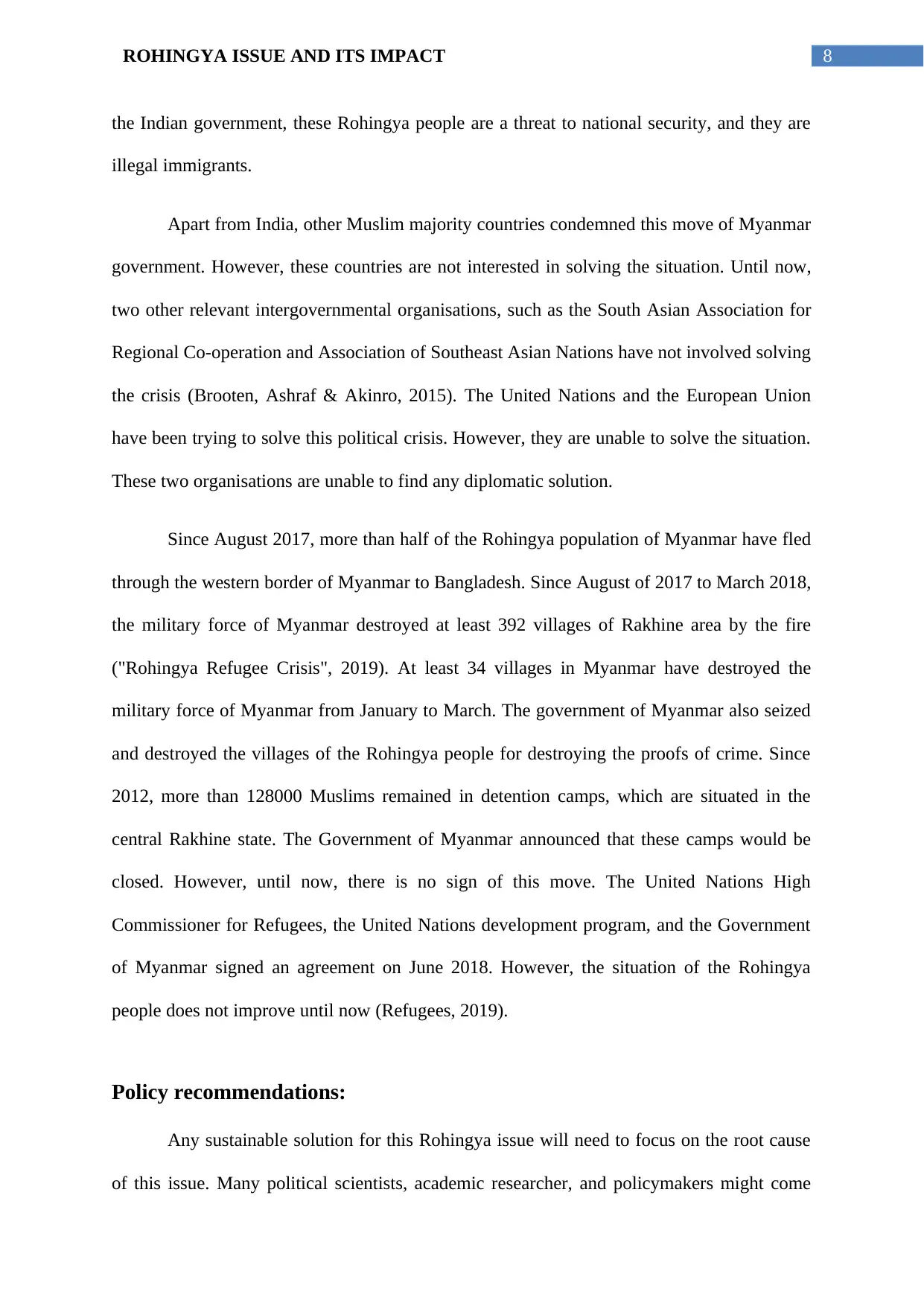
8ROHINGYA ISSUE AND ITS IMPACT
the Indian government, these Rohingya people are a threat to national security, and they are
illegal immigrants.
Apart from India, other Muslim majority countries condemned this move of Myanmar
government. However, these countries are not interested in solving the situation. Until now,
two other relevant intergovernmental organisations, such as the South Asian Association for
Regional Co-operation and Association of Southeast Asian Nations have not involved solving
the crisis (Brooten, Ashraf & Akinro, 2015). The United Nations and the European Union
have been trying to solve this political crisis. However, they are unable to solve the situation.
These two organisations are unable to find any diplomatic solution.
Since August 2017, more than half of the Rohingya population of Myanmar have fled
through the western border of Myanmar to Bangladesh. Since August of 2017 to March 2018,
the military force of Myanmar destroyed at least 392 villages of Rakhine area by the fire
("Rohingya Refugee Crisis", 2019). At least 34 villages in Myanmar have destroyed the
military force of Myanmar from January to March. The government of Myanmar also seized
and destroyed the villages of the Rohingya people for destroying the proofs of crime. Since
2012, more than 128000 Muslims remained in detention camps, which are situated in the
central Rakhine state. The Government of Myanmar announced that these camps would be
closed. However, until now, there is no sign of this move. The United Nations High
Commissioner for Refugees, the United Nations development program, and the Government
of Myanmar signed an agreement on June 2018. However, the situation of the Rohingya
people does not improve until now (Refugees, 2019).
Policy recommendations:
Any sustainable solution for this Rohingya issue will need to focus on the root cause
of this issue. Many political scientists, academic researcher, and policymakers might come
the Indian government, these Rohingya people are a threat to national security, and they are
illegal immigrants.
Apart from India, other Muslim majority countries condemned this move of Myanmar
government. However, these countries are not interested in solving the situation. Until now,
two other relevant intergovernmental organisations, such as the South Asian Association for
Regional Co-operation and Association of Southeast Asian Nations have not involved solving
the crisis (Brooten, Ashraf & Akinro, 2015). The United Nations and the European Union
have been trying to solve this political crisis. However, they are unable to solve the situation.
These two organisations are unable to find any diplomatic solution.
Since August 2017, more than half of the Rohingya population of Myanmar have fled
through the western border of Myanmar to Bangladesh. Since August of 2017 to March 2018,
the military force of Myanmar destroyed at least 392 villages of Rakhine area by the fire
("Rohingya Refugee Crisis", 2019). At least 34 villages in Myanmar have destroyed the
military force of Myanmar from January to March. The government of Myanmar also seized
and destroyed the villages of the Rohingya people for destroying the proofs of crime. Since
2012, more than 128000 Muslims remained in detention camps, which are situated in the
central Rakhine state. The Government of Myanmar announced that these camps would be
closed. However, until now, there is no sign of this move. The United Nations High
Commissioner for Refugees, the United Nations development program, and the Government
of Myanmar signed an agreement on June 2018. However, the situation of the Rohingya
people does not improve until now (Refugees, 2019).
Policy recommendations:
Any sustainable solution for this Rohingya issue will need to focus on the root cause
of this issue. Many political scientists, academic researcher, and policymakers might come
⊘ This is a preview!⊘
Do you want full access?
Subscribe today to unlock all pages.

Trusted by 1+ million students worldwide
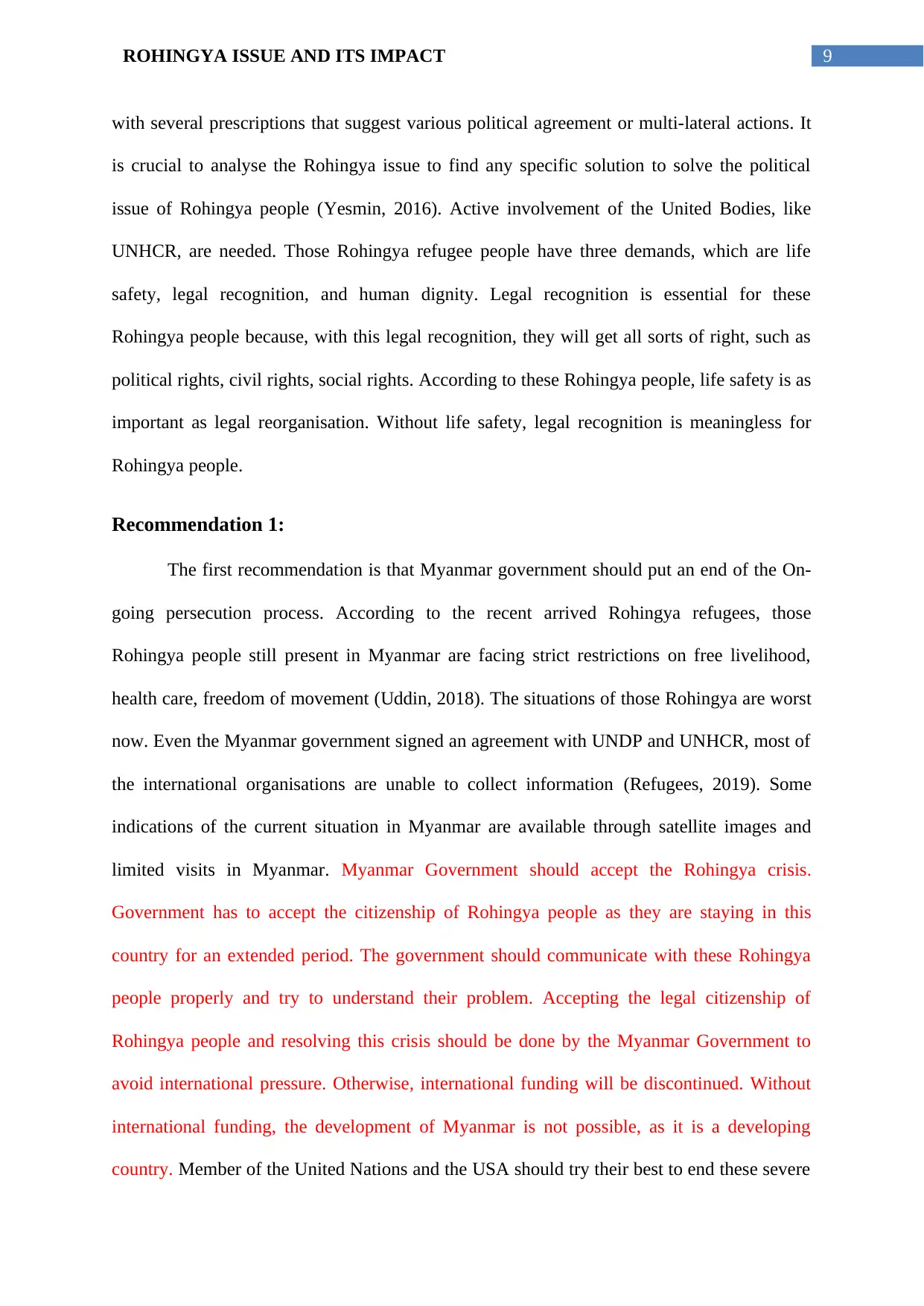
9ROHINGYA ISSUE AND ITS IMPACT
with several prescriptions that suggest various political agreement or multi-lateral actions. It
is crucial to analyse the Rohingya issue to find any specific solution to solve the political
issue of Rohingya people (Yesmin, 2016). Active involvement of the United Bodies, like
UNHCR, are needed. Those Rohingya refugee people have three demands, which are life
safety, legal recognition, and human dignity. Legal recognition is essential for these
Rohingya people because, with this legal recognition, they will get all sorts of right, such as
political rights, civil rights, social rights. According to these Rohingya people, life safety is as
important as legal reorganisation. Without life safety, legal recognition is meaningless for
Rohingya people.
Recommendation 1:
The first recommendation is that Myanmar government should put an end of the On-
going persecution process. According to the recent arrived Rohingya refugees, those
Rohingya people still present in Myanmar are facing strict restrictions on free livelihood,
health care, freedom of movement (Uddin, 2018). The situations of those Rohingya are worst
now. Even the Myanmar government signed an agreement with UNDP and UNHCR, most of
the international organisations are unable to collect information (Refugees, 2019). Some
indications of the current situation in Myanmar are available through satellite images and
limited visits in Myanmar. Myanmar Government should accept the Rohingya crisis.
Government has to accept the citizenship of Rohingya people as they are staying in this
country for an extended period. The government should communicate with these Rohingya
people properly and try to understand their problem. Accepting the legal citizenship of
Rohingya people and resolving this crisis should be done by the Myanmar Government to
avoid international pressure. Otherwise, international funding will be discontinued. Without
international funding, the development of Myanmar is not possible, as it is a developing
country. Member of the United Nations and the USA should try their best to end these severe
with several prescriptions that suggest various political agreement or multi-lateral actions. It
is crucial to analyse the Rohingya issue to find any specific solution to solve the political
issue of Rohingya people (Yesmin, 2016). Active involvement of the United Bodies, like
UNHCR, are needed. Those Rohingya refugee people have three demands, which are life
safety, legal recognition, and human dignity. Legal recognition is essential for these
Rohingya people because, with this legal recognition, they will get all sorts of right, such as
political rights, civil rights, social rights. According to these Rohingya people, life safety is as
important as legal reorganisation. Without life safety, legal recognition is meaningless for
Rohingya people.
Recommendation 1:
The first recommendation is that Myanmar government should put an end of the On-
going persecution process. According to the recent arrived Rohingya refugees, those
Rohingya people still present in Myanmar are facing strict restrictions on free livelihood,
health care, freedom of movement (Uddin, 2018). The situations of those Rohingya are worst
now. Even the Myanmar government signed an agreement with UNDP and UNHCR, most of
the international organisations are unable to collect information (Refugees, 2019). Some
indications of the current situation in Myanmar are available through satellite images and
limited visits in Myanmar. Myanmar Government should accept the Rohingya crisis.
Government has to accept the citizenship of Rohingya people as they are staying in this
country for an extended period. The government should communicate with these Rohingya
people properly and try to understand their problem. Accepting the legal citizenship of
Rohingya people and resolving this crisis should be done by the Myanmar Government to
avoid international pressure. Otherwise, international funding will be discontinued. Without
international funding, the development of Myanmar is not possible, as it is a developing
country. Member of the United Nations and the USA should try their best to end these severe
Paraphrase This Document
Need a fresh take? Get an instant paraphrase of this document with our AI Paraphraser
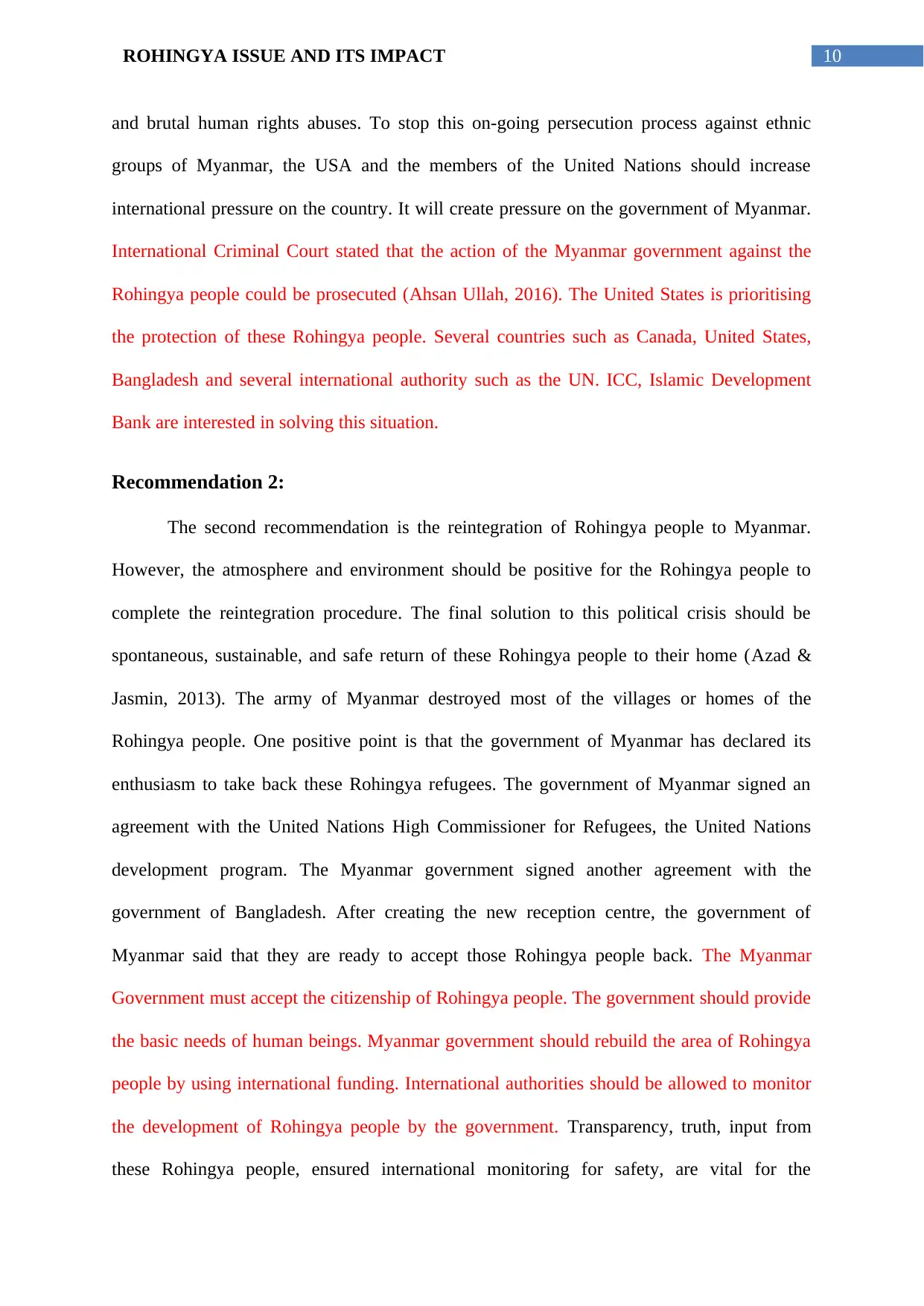
10ROHINGYA ISSUE AND ITS IMPACT
and brutal human rights abuses. To stop this on-going persecution process against ethnic
groups of Myanmar, the USA and the members of the United Nations should increase
international pressure on the country. It will create pressure on the government of Myanmar.
International Criminal Court stated that the action of the Myanmar government against the
Rohingya people could be prosecuted (Ahsan Ullah, 2016). The United States is prioritising
the protection of these Rohingya people. Several countries such as Canada, United States,
Bangladesh and several international authority such as the UN. ICC, Islamic Development
Bank are interested in solving this situation.
Recommendation 2:
The second recommendation is the reintegration of Rohingya people to Myanmar.
However, the atmosphere and environment should be positive for the Rohingya people to
complete the reintegration procedure. The final solution to this political crisis should be
spontaneous, sustainable, and safe return of these Rohingya people to their home (Azad &
Jasmin, 2013). The army of Myanmar destroyed most of the villages or homes of the
Rohingya people. One positive point is that the government of Myanmar has declared its
enthusiasm to take back these Rohingya refugees. The government of Myanmar signed an
agreement with the United Nations High Commissioner for Refugees, the United Nations
development program. The Myanmar government signed another agreement with the
government of Bangladesh. After creating the new reception centre, the government of
Myanmar said that they are ready to accept those Rohingya people back. The Myanmar
Government must accept the citizenship of Rohingya people. The government should provide
the basic needs of human beings. Myanmar government should rebuild the area of Rohingya
people by using international funding. International authorities should be allowed to monitor
the development of Rohingya people by the government. Transparency, truth, input from
these Rohingya people, ensured international monitoring for safety, are vital for the
and brutal human rights abuses. To stop this on-going persecution process against ethnic
groups of Myanmar, the USA and the members of the United Nations should increase
international pressure on the country. It will create pressure on the government of Myanmar.
International Criminal Court stated that the action of the Myanmar government against the
Rohingya people could be prosecuted (Ahsan Ullah, 2016). The United States is prioritising
the protection of these Rohingya people. Several countries such as Canada, United States,
Bangladesh and several international authority such as the UN. ICC, Islamic Development
Bank are interested in solving this situation.
Recommendation 2:
The second recommendation is the reintegration of Rohingya people to Myanmar.
However, the atmosphere and environment should be positive for the Rohingya people to
complete the reintegration procedure. The final solution to this political crisis should be
spontaneous, sustainable, and safe return of these Rohingya people to their home (Azad &
Jasmin, 2013). The army of Myanmar destroyed most of the villages or homes of the
Rohingya people. One positive point is that the government of Myanmar has declared its
enthusiasm to take back these Rohingya refugees. The government of Myanmar signed an
agreement with the United Nations High Commissioner for Refugees, the United Nations
development program. The Myanmar government signed another agreement with the
government of Bangladesh. After creating the new reception centre, the government of
Myanmar said that they are ready to accept those Rohingya people back. The Myanmar
Government must accept the citizenship of Rohingya people. The government should provide
the basic needs of human beings. Myanmar government should rebuild the area of Rohingya
people by using international funding. International authorities should be allowed to monitor
the development of Rohingya people by the government. Transparency, truth, input from
these Rohingya people, ensured international monitoring for safety, are vital for the
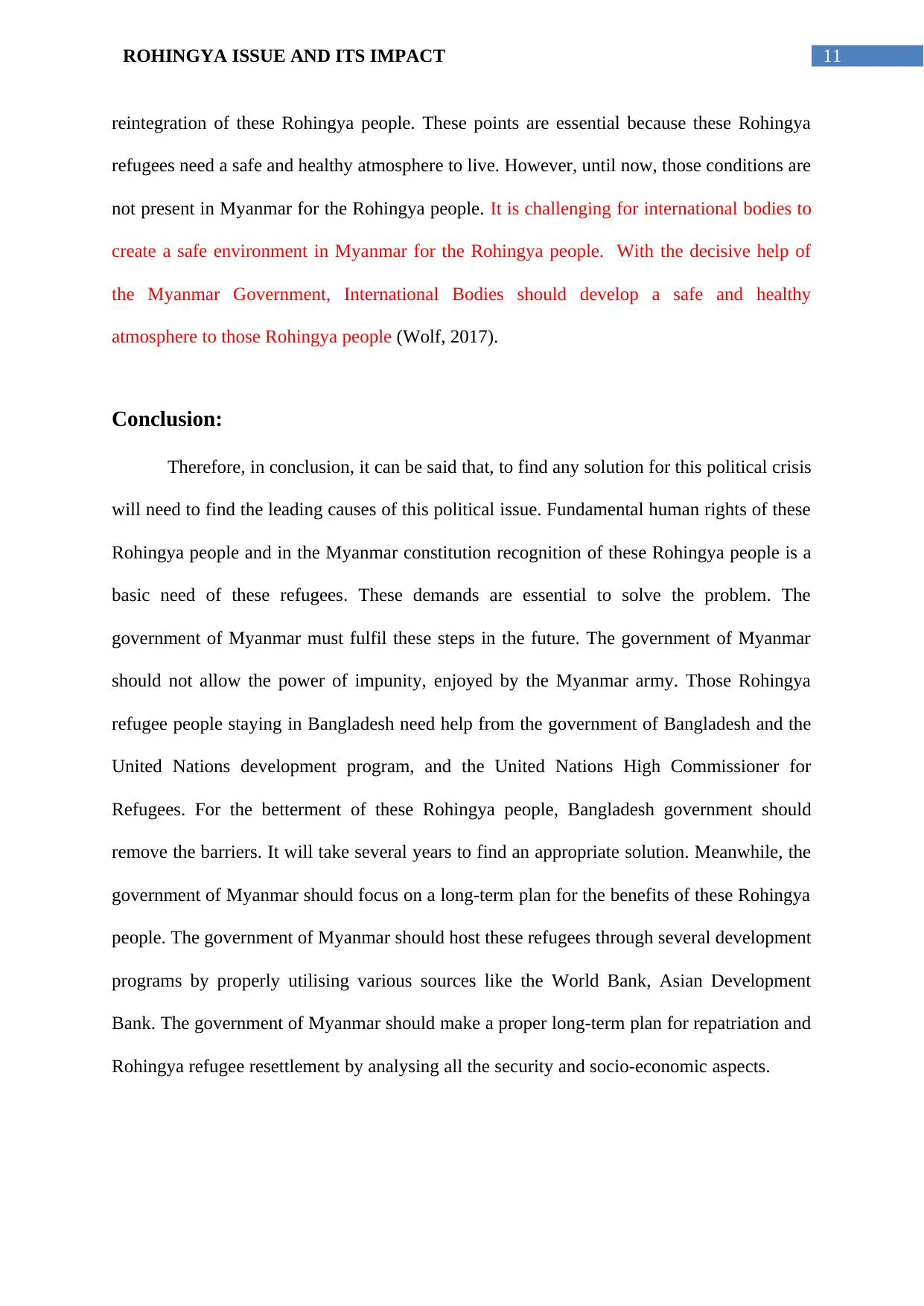
11ROHINGYA ISSUE AND ITS IMPACT
reintegration of these Rohingya people. These points are essential because these Rohingya
refugees need a safe and healthy atmosphere to live. However, until now, those conditions are
not present in Myanmar for the Rohingya people. It is challenging for international bodies to
create a safe environment in Myanmar for the Rohingya people. With the decisive help of
the Myanmar Government, International Bodies should develop a safe and healthy
atmosphere to those Rohingya people (Wolf, 2017).
Conclusion:
Therefore, in conclusion, it can be said that, to find any solution for this political crisis
will need to find the leading causes of this political issue. Fundamental human rights of these
Rohingya people and in the Myanmar constitution recognition of these Rohingya people is a
basic need of these refugees. These demands are essential to solve the problem. The
government of Myanmar must fulfil these steps in the future. The government of Myanmar
should not allow the power of impunity, enjoyed by the Myanmar army. Those Rohingya
refugee people staying in Bangladesh need help from the government of Bangladesh and the
United Nations development program, and the United Nations High Commissioner for
Refugees. For the betterment of these Rohingya people, Bangladesh government should
remove the barriers. It will take several years to find an appropriate solution. Meanwhile, the
government of Myanmar should focus on a long-term plan for the benefits of these Rohingya
people. The government of Myanmar should host these refugees through several development
programs by properly utilising various sources like the World Bank, Asian Development
Bank. The government of Myanmar should make a proper long-term plan for repatriation and
Rohingya refugee resettlement by analysing all the security and socio-economic aspects.
reintegration of these Rohingya people. These points are essential because these Rohingya
refugees need a safe and healthy atmosphere to live. However, until now, those conditions are
not present in Myanmar for the Rohingya people. It is challenging for international bodies to
create a safe environment in Myanmar for the Rohingya people. With the decisive help of
the Myanmar Government, International Bodies should develop a safe and healthy
atmosphere to those Rohingya people (Wolf, 2017).
Conclusion:
Therefore, in conclusion, it can be said that, to find any solution for this political crisis
will need to find the leading causes of this political issue. Fundamental human rights of these
Rohingya people and in the Myanmar constitution recognition of these Rohingya people is a
basic need of these refugees. These demands are essential to solve the problem. The
government of Myanmar must fulfil these steps in the future. The government of Myanmar
should not allow the power of impunity, enjoyed by the Myanmar army. Those Rohingya
refugee people staying in Bangladesh need help from the government of Bangladesh and the
United Nations development program, and the United Nations High Commissioner for
Refugees. For the betterment of these Rohingya people, Bangladesh government should
remove the barriers. It will take several years to find an appropriate solution. Meanwhile, the
government of Myanmar should focus on a long-term plan for the benefits of these Rohingya
people. The government of Myanmar should host these refugees through several development
programs by properly utilising various sources like the World Bank, Asian Development
Bank. The government of Myanmar should make a proper long-term plan for repatriation and
Rohingya refugee resettlement by analysing all the security and socio-economic aspects.
⊘ This is a preview!⊘
Do you want full access?
Subscribe today to unlock all pages.

Trusted by 1+ million students worldwide
1 out of 15
Related Documents
Your All-in-One AI-Powered Toolkit for Academic Success.
+13062052269
info@desklib.com
Available 24*7 on WhatsApp / Email
![[object Object]](/_next/static/media/star-bottom.7253800d.svg)
Unlock your academic potential
Copyright © 2020–2025 A2Z Services. All Rights Reserved. Developed and managed by ZUCOL.





